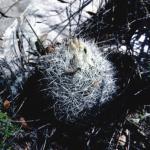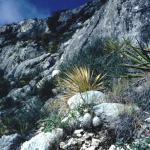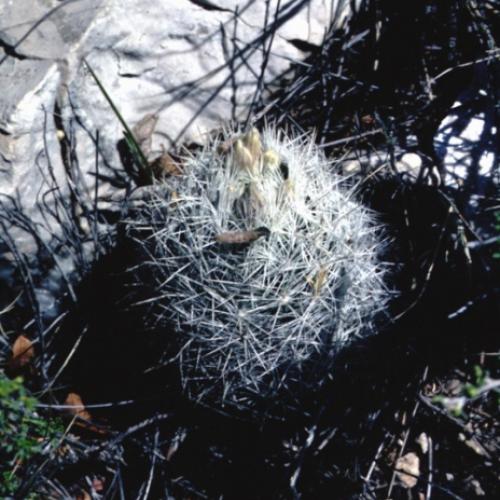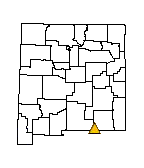Escobaria guadalupensis (Guadalupe Pincushion Cactus)
Family
CACTACEAE
Synonyms
NONE
Common Name
Guadalupe Pincushion Cactus
| USFWS | State of NM | USFS | BLM | Navajo Nation | State Rank | Global Rank | R-E-D Code | NMRPTC Status | Strategy Status |
|---|---|---|---|---|---|---|---|---|---|
| S1 | G1 | 2-1-2 | R | SS |
| Overall Conservation Status | Documented Threats | Actions Needed |
|---|---|---|
| WEAKLY CONSERVED | No information |
taxonomic issues. Determine rarity |
Description
Stems mostly solitary or sometimes up to 5 in a clump, globose to obovoid, the individual stems mostly 3-5 cm thick and 4-10 cm tall; tubercles on mature stems with upper surface grooved; spines about 50-60 per areole, spreading, typically white, often darker at tip, fading to gray, about 70 percent slender and about 7-12 mm long, the remainder thicker and 8-14 mm long; flowers not opening widely, to 2 cm wide (usually smaller); tepals pale yellowish to pinkish or nearly white, usually with midribs darker; stigmas white to pink; fruits elongate, 1.5-2 cm long, green to somewhat reddish; seeds about 1 mm long, kidney-shaped, pitted, brown, with hilum lateral. Flowers April and May.
Similar Species
Escobaria tuberculosa usually has more richly colored flowers that open widely, fruits that ripen bright red, and seeds that are smaller and rounder. Escobaria guadalupensis is larger and less clustering than E. sneedii var. sneedii and has stems that are more ovoid and less clustering than E. organensis, E. sandbergii, E. villardii, E. orcuttii, and E. albicolumnaria, which are other members of the Escobaria sneedii Complex.
Distribution
New Mexico, Eddy County; Texas, Culberson and Hudspeth counties.
Habitat
Cracks in limestone and rocky soils of broken mountainous terrain in open oak and piñon-juniper woodland, but also lower montane coniferous forest and Chihuahuan desert scrub; 1,600-2,200 m (5,200-7,200 ft).
Remarks
In Flora of North America, Volume 4 (2003), all taxa in the Escobaria sneedii Complex, which includes Escobaria guadalupensis, have been submerged into a single highly variable species, Coryphantha sneedii, without recognition of subspecific taxa. The NMRPTC notes the subjectivity involved in taxonomic decisions within this complex and will continue to consider E. guadalupensis to be a distinct entity. In discussions at the 2005 New Mexico Rare Plant Technical Council Meeting, Council members concluded that E. guadalupensis represents a population of plants that is geographically defined and sufficiently distinct from other closely related populations that it deserves taxonomic recognition. Although the population of E. guadalupensis is distinct as a whole, it may be difficult to assign some plants in the population to a specific taxon without detailed analysis because it intergrades with E. sneedii var. leei found at lower elevations in the Guadalupe Mountains north of the general distribution of E. guadalupensis (Baker and Johnson 2000). Some give these intermediate plants the name E. sneedii var. sneedii.
Conservation Considerations
This species is common in its area of distribution. There are no known threats to populations at this time.
Important Literature
*Brack, S. and K.D. Heil. 1986. The cacti of Guadalupe Mountains National Park. Cactus and Succulent Journal (U.S.) 58(4):165-177.
Flora of North America Editorial Committee. 2003. Flora of North America, volume 4. Oxford University Press, New York.
Baker, M.A. and R.A. Johnson. 2000. Morphometric analysis of Escobaria sneedii var. sneedii, E. sneedii var. leei, and E. guadalupensis (Cactaceae). Systematic Botany 25(4):577-587.
Information Compiled By
David J. Ferguson 1998; last updated 2006
For distribution maps and more information, visit Natural Heritage New Mexico




